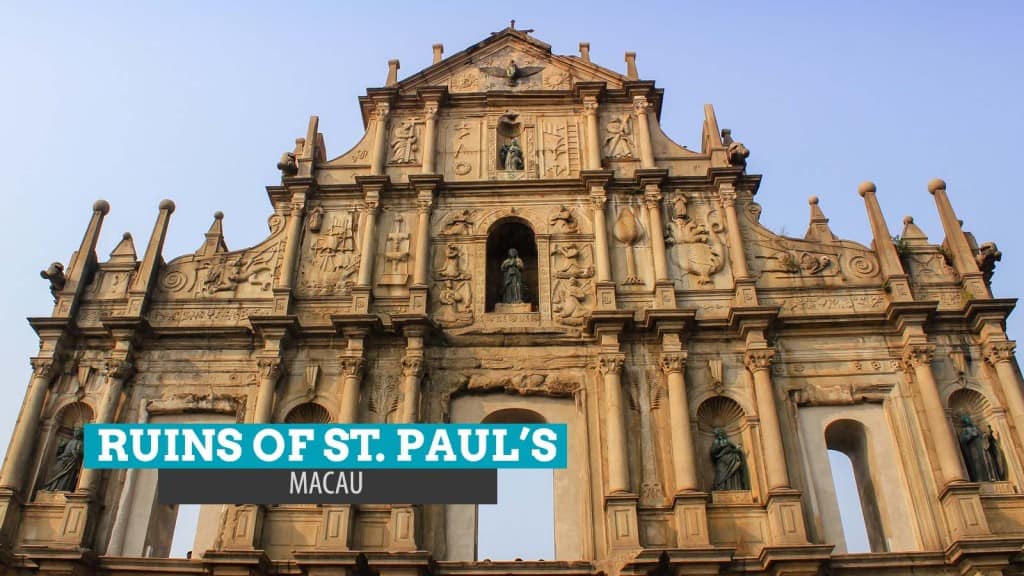Everything comes in threes.
Miss the third strike, and you’re out. If the Ruins of St. Paul’s were a baseball player, that’s exactly what would have happened. Except, even when it has been out of the game, the Ruins of St. Paul still managed to emerge as a major superstar.
Déjà vu. It was my first time in Macau, but the site was fostering an atmosphere that was familiar. As I moved farther from the structure to squeeze everything in my viewfinder, it dawned on me what it reminded me of — St. Paul’s Church of Malacca, Malaysia. Both stand on top of a hill, adjacent to a fortress. Both were named after St. Paul. Both used to harbor a church and a college. Both complexes were built under the Portuguese in the 16th century. Both are now down to ruins. Both structures have become iconic landmarks of the cities that cradle them. And both left me breathless. But despite the many similarities, the Ruins of St. Paul’s possesses a charm of its own.
History: The Three Strikes
The Ruins of St. Paul’s does not refer to the cathedral alone. Built in the 16th century, the site was actually a complex that nestled an educational institution and the church (but the church itself was built later in the 17th century). Today, however, only the facade and the stairs remain standing. What happened? A big fire.
Fire was not really stranger to what used to be the greatest church in Macau.
The original church was built in the 1580s by local craftsmen and Japanese Christians, who, according to this report, had fled persecution in their home country. It was constructed under the supervision and direction of Jesuit Missionaries. In 1595, however, the church had its first encounter with fire. It remained standing only to catch another big fire, which burned down the church, in 1601. The next year, 1602, reconstruction commenced and was finally completed in 1637. It was said to be built with white stones, featured an ornate baroque-style facade, and was topped with a majestic vaulted roof, giving shade to three massive halls. It became East Asia’s biggest Catholic Church.
Disaster struck again in 1835, two centuries later, when a typhoon ravaged the city, causing another big fire, the third and the last in its long history.
St. Paul Ruins Architecture
The surviving wall boasts a Baroque design and has four tiers topped with a gable. Each tier is heavily ornamented with relief carvings, statues, and a colonnade. The bottom two layers had 10 columns each, divided into four groups of two and three. Three arch windows that used to front vaulted halls decorate the upper tier along with four statues of Catholic saints enshrined in shallow four shallow niches. Rectangular doorways take their place in the bottom layer.
The top two tiers bear fewer columns but richer details. These highly ornate levels possess finials and more carvings, narrowing as they get higher and finally reaching the triangular gable. Each upper layer is ornamented with a deep niche housing a statue in the middle — the Virgin Mary in the third and Jesus Christ in the fourth — and bas reliefs of patterns and figures of angels, devils, Portuguese ships, Chinese inscriptions, even cherry. The sides of these upper tiers have stone Chinese lions, adding a more Oriental feel to the already healthy mixture of Western and Eastern influences. An image of a bird (dove representing the Holy Spirit?) takes the center of the gable. Visitors are ushered towards the facade by the 66-step staircase flanked by a cleverly decorated garden.
Behind the wall lies the relics of the pillars and other parts of the Church, protected by glass. A series of photos is also exhibited on one side, providing more information to visitors, who can also take the narrow flight of stairs to the upper level of the wall for a gorgeous view of the surrounding cityscape. From here, you can spot the Grand Lisboa building, the Na Tcha Temple, and the crowded alleys that lead to Senado Square.
After exploring the site, the Poor Traveler headed to Senado Square but because I wanted to see how it looked at night, I went back to see it against a spectacular fire show — the sunset.
St. Paul Ruins may have been struck by fire three times in the past but it proved that something so beautiful can always be in the game, albeit different, as long as there are people who would work hard to revive and restore it. Three strikes? Maybe. But certainly not out.
Posted: 2012 • 9 • 10
